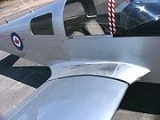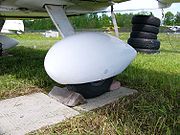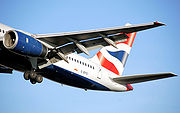
Fairing
Encyclopedia
A fairing is a structure whose primary function is to produce a smooth outline and reduce drag
.
These structures are covers for gaps and spaces between parts of an aircraft
to reduce form drag and interference drag, and to improve appearance.

Elevator and horizontal stabilizer tips
Engine cowling
s
Fin and rudder tips
Fixed landing gear
junctions
Flap track fairings
Spinner
Strut-to-wing and strut-to-fuselage
junctions
Tail cones
Wing root
 Wing tips
Wing tips
Wheels on fixed gear aircraft
Drag (physics)
In fluid dynamics, drag refers to forces which act on a solid object in the direction of the relative fluid flow velocity...
.
These structures are covers for gaps and spaces between parts of an aircraft
Aircraft
An aircraft is a vehicle that is able to fly by gaining support from the air, or, in general, the atmosphere of a planet. An aircraft counters the force of gravity by using either static lift or by using the dynamic lift of an airfoil, or in a few cases the downward thrust from jet engines.Although...
to reduce form drag and interference drag, and to improve appearance.

Types
On aircraft, fairings are commonly found on:Elevator and horizontal stabilizer tips
Elevator (aircraft)
Elevators are flight control surfaces, usually at the rear of an aircraft, which control the aircraft's orientation by changing the pitch of the aircraft, and so also the angle of attack of the wing. In simplified terms, they make the aircraft nose-up or nose-down...
- Elevator and stabilizer tips fairings smooth out airflow at the tips.
Engine cowling
Cowling
A cowling is the covering of a vehicle's engine, most often found on automobiles and aircraft.A cowling may be used:* for drag reduction* for engine cooling by directing airflow* as an air intake for jet engines* for decorative purposes...
s
- Engine cowlings reduce parasitic dragParasitic dragParasitic drag is drag caused by moving a solid object through a fluid medium . Parasitic drag is made up of many components, the most prominent being form drag...
by reducing the surface area, having a smooth surface and thus leading to laminar flowLaminar flowLaminar flow, sometimes known as streamline flow, occurs when a fluid flows in parallel layers, with no disruption between the layers. At low velocities the fluid tends to flow without lateral mixing, and adjacent layers slide past one another like playing cards. There are no cross currents...
, and having a nose cone shape, which prevents early flow separationFlow separationAll solid objects travelling through a fluid acquire a boundary layer of fluid around them where viscous forces occur in the layer of fluid close to the solid surface. Boundary layers can be either laminar or turbulent...
. The inletInletAn inlet is a narrow body of water between islands or leading inland from a larger body of water, often leading to an enclosed body of water, such as a sound, bay, lagoon or marsh. In sea coasts an inlet usually refers to the actual connection between a bay and the ocean and is often called an...
and the nozzleNozzleA nozzle is a device designed to control the direction or characteristics of a fluid flow as it exits an enclosed chamber or pipe via an orifice....
in combination lead to an isotropic speed reduction around the cooling fins and due to the speed-squared law to a reduction in cooling drag.
Fin and rudder tips
Rudder
A rudder is a device used to steer a ship, boat, submarine, hovercraft, aircraft or other conveyance that moves through a medium . On an aircraft the rudder is used primarily to counter adverse yaw and p-factor and is not the primary control used to turn the airplane...
- Fin and rudder tip fairings reduce turbulence at the tips.
Fixed landing gear
Landing Gear
Landing Gear is Devin the Dude's fifth studio album. It was released on October 7, 2008. It was his first studio album since signing with the label Razor & Tie. It features a high-profile guest appearance from Snoop Dogg. As of October 30, 2008, the album has sold 18,906 copies.-Track...
junctions
- Landing gear fairings reduce drag at these junctions.
Flap track fairings
- Most jet airlinerJet airlinerA jet airliner is an airliner that is powered by jet engines. This term is sometimes contracted to jetliner or jet.In contrast to today's relatively fuel-efficient, turbofan-powered air travel, first generation jet airliner travel was noisy and fuel inefficient...
s have a cruising speed between Mach 0.8 and 0.85. For aircraft operating in the transonicTransonicTransonic speed is an aeronautics term referring to the condition of flight in which a range of velocities of airflow exist surrounding and flowing past an air vehicle or an airfoil that are concurrently below, at, and above the speed of sound in the range of Mach 0.8 to 1.2, i.e. 600–900 mph...
regime (about MachMach numberMach number is the speed of an object moving through air, or any other fluid substance, divided by the speed of sound as it is in that substance for its particular physical conditions, including those of temperature and pressure...
0.8–1.2), wave dragWave dragIn aeronautics, wave drag is a component of the drag on aircraft, blade tips and projectiles moving at transonic and supersonic speeds, due to the presence of shock waves. Wave drag is independent of viscous effects.- Overview :...
can be minimized by having a cross-sectionalCross section (geometry)In geometry, a cross-section is the intersection of a figure in 2-dimensional space with a line, or of a body in 3-dimensional space with a plane, etc...
area which changes smoothly along the length of the aircraft. This is known as the area ruleArea ruleThe Whitcomb area rule, also called the transonic area rule, is a design technique used to reduce an aircraft's drag at transonic and supersonic speeds, particularly between Mach 0.75 and 1.2....
. On subsonic aircraft such as jet airliners, this can be achieved by the addition of smooth pods on the trailing edges of the wings. These pods are known as anti-shock bodiesAnti-shock bodyAn Anti-shock body is a pod positioned on the leading or trailing edge of an aircraft's aerodynamic surface to reduce wave drag at transonic speeds .-Wing trailing edge:...
, Küchemann Carrots, or flap track fairings, as they enclose the mechanisms for deploying the wing flapsFlap (aircraft)Flaps are normally hinged surfaces mounted on the trailing edges of the wings of a fixed-wing aircraft to reduce the speed an aircraft can be safely flown at and to increase the angle of descent for landing without increasing air speed. They shorten takeoff and landing distances as well as...
.
Spinner
Spinner (aircraft)
A spinner is an aircraft component, a streamlined fairing fitted over a propeller hub or at the centre of a turbofan engine. Spinners both make the aircraft over all more streamlined, reducing aerodynamic drag and also smooth the airflow so that it enters the air intakes more efficiently...
- To cover and streamline the propeller hub.
Strut-to-wing and strut-to-fuselage
Fuselage
The fuselage is an aircraft's main body section that holds crew and passengers or cargo. In single-engine aircraft it will usually contain an engine, although in some amphibious aircraft the single engine is mounted on a pylon attached to the fuselage which in turn is used as a floating hull...
junctions
- Strut end fairings reduce drag at these junctions.
Tail cones
- Tail cones reduce the form drag of the fuselage, by recovering the pressure behind it. For the design speed they add no friction drag.
Wing root
Wing root
The wing root is the part of the wing on a fixed-wing aircraft that is closest to the fuselage. On a simple monoplane configuration, this is usually easy to identify...
- Wing roots are often faired to reduce interference drag between the wing and the fuselage. On top and below the wing it consists of small rounded edge to reduce the surface and such friction drag. At the leading and trailing edge it consists of much larger taper and smooths out the pressure differences: High pressure at the leading and trailing edge, low pressure on top of the wing and around the fuselage.

- Wing tips are often formed as complex shapes to reduce vortex generation and so also drag, especially at low speed.
Wheels on fixed gear aircraft
- Wheel fairings are often called "wheel pants", "speed fairings" or, in the UKUnited KingdomThe United Kingdom of Great Britain and Northern IrelandIn the United Kingdom and Dependencies, other languages have been officially recognised as legitimate autochthonous languages under the European Charter for Regional or Minority Languages...
, "wheel spats". These fairings are a trade-off in advantages, as they increase the frontal and surface area, but also provide a smooth surface, a faired nose and tail for laminar flow, in an attempt to reduce the turbulence created by the round wheel and its associated gear legs and brakes. They also have the important function of preventing mud and stones from being thrown upwards against the wings or fuselage, or into the propeller on a pusher craft.

